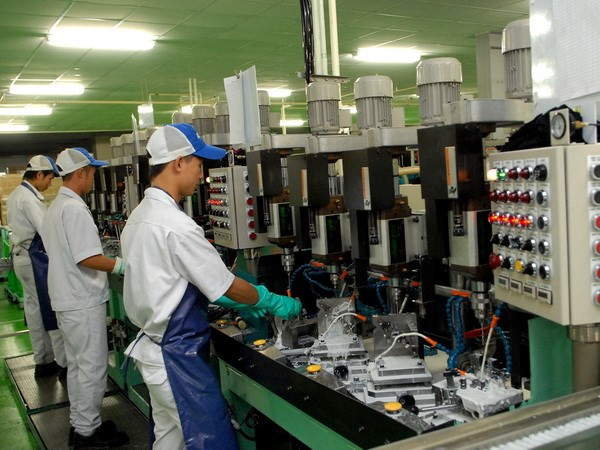 An auto component production line of Keihin Vietnam Co Ltd. The issues around the pandemic and price rises also impacted new orders at the end of the first quarter (Photo: VNA)
An auto component production line of Keihin Vietnam Co Ltd. The issues around the pandemic and price rises also impacted new orders at the end of the first quarter (Photo: VNA)In a report released last week, S&P Global said that although the situationstill pointed to an overall strengthening of business conditions, the latestimprovement was the least marked in the current six-month sequence of growth.
Central to the slowdown in the rate of improvement overall was the current waveof the COVID-19 pandemic in Vietnam. One of the main impacts on firms came inthe form of widespread infections among workers, resulting in a first declinein employment in four months, according to the report.
Staff shortages meant that firms were unable to maintain production volumes,with output falling for the first time in six months. Inflationary pressuresalso contributed to the drop in production, which was nonetheless only modestas some firms expanded output in line with higher new orders.
Difficulties raising production due to labour shortages led to a furtheraccumulation of backlogs of work, with the latest increase the most markedsince September last year.
The report said the issues around the pandemic and price rises also impactednew orders at the end of the first quarter. That said both total new businessand new export orders increased for the sixth month running.
Efforts to keep up with order requirements were helped by the use ofinventories given difficulties with production. As a result, stocks of finishedgoods decreased for the first time in three months.
The aforementioned inflationary pressures were highlighted by both of thesurvey's price indices in March.
The rate of input cost inflation surged higher, reaching the fastest in close to11 years. More than half of all respondents signalled that their input priceshad risen over the month, with higher costs for oil and gas mentioned inparticular. Rising shipping and raw material prices were also cited.
In turn, manufacturers raised their selling prices at an accelerated pace. Theincrease was the fastest since last November's ten-and-a-half year high.
Although purchasing activity rose slightly in March, the rate of growth slowedsharply and was the weakest in the current six-month sequence of expansion.Stocks of purchases were also up modestly. With current production requirementsfalling, any inventory building largely reflected efforts to accumulatereserves.
A range of factors led to longer suppliers' delivery times in March, includingthe effects of the COVID-19 pandemic such as labour shortages and restrictionsat the border with China. The war in Ukraine also acted to delay deliveries,with lead times lengthening to the greatest extent since last October overall.
According to the report, the severity of the latest wave of the COVID-19pandemic and worries about inflationary pressures acted to dampen expectationsfor the future. Business confidence dropped to the lowest in six months.However, firms remain optimistic that output will rise over the coming year,based on hopes that the pandemic will fade and new orders expand.
Andrew Harker, Economics Director at S&P Global, said: “The surge inCOVID-19 cases in Vietnam during March took its toll on the manufacturingsector, pushing output back into contraction territory. This was primarily dueto labour shortages, as so many workers were off with infections that factorieswere unable to maintain production volumes.
"While firms will be hoping that infection levels start to ease soon,providing some alleviation on that front, the war in Ukraine provides a furtherheadwind. The most noticeable impact for Vietnamese firms in March was onprices. Input costs increased at the sharpest pace in almost 11 years on theback of higher costs for oil and gas following the outbreak of war. This hasdashed any hopes that inflationary pressures might be set to ease over themonths ahead."/.




























